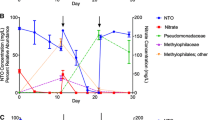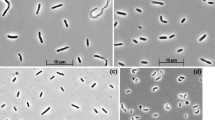Abstract
Degradation of dipicolinic acid (pyridine-2,6-dicarboxylic acid) under strictly anaerobic conditions was studied in enrichment cultures from marine and freshwater sediments. In all cases, dipicolinic acid was completely degraded. From an enrichment culture from a marine sediment, a defined coculture of two bacteria was isolated. The dipicolinic acid-fermenting bacterium was a Gram-negative, non-sporeforming strictly anaerobic short rod which utilized dipicolinic acid as sole source of carbon, energy, and nitrogen, and fermented it to acetate, propionate, ammonia, and 2CO2. No other substrate was fermented. This bacterium could be cultivated only in coculture with another Gram-negative, non-sporeforming rod from the same enrichment culture which oxidized acetate to CO2 with fumarate, malate, or elemental sulfur as electron acceptor, similar to Desulfuromonas acetoxidans. Since this metabolic activity is not important in substrate degradation by the coculture, the basis of the dependence of the dipicolinic acid-degrading bacterium on the sulfur reducer may be sought in the assimilatory metabolism.
Similar content being viewed by others
References
Arima, K, Kobayashi, Y (1962) Bacterial oxidation of dipicolinic acid. I. Isolation of microorganisms, their culture conditions, and end products. J Bacteriol 84: 759–764
Bergmeyer, HU (1974) Methoden der enzymatischen Analyse. 3rd ed., Verlag Chemie, Weinheim
Boonstra, J, Huttunen, MT & Konings, WN (1975) Anaerobic transport in Escherichia coli membrane vesicles. J Biol Chem 250: 6792–6798
Dagley, S & Johnson, PA (1963) Microbial oxidation of kynurenic, xanthurenic and picolinic acid. Biochim Biophys Acta 78: 577–587
Dehning, I & Schink, B (1989) Malonomonas rubra gen. nov. sp. nov., a microaerotolerant anaerobic bacterium growing by decarboxylation of malonate. Arch Microbiol 151: 427–433
Harary, J (1957) Bacterial fermentation of nicotinic acid. II. Anaerobic reversible hydroxylation of nicotinic acid to 6-hydroxynicotinic acid. J Biol Chem 227: 823–831
Hilpert, W, Schink, B & Dimroth, P (1984) Life by a new decarboxylation-dependent energy conservation mechanism with Na+ as a coupling ion. EMBO J 3: 1665–1670
Hirschberg, R & Ensign, JC (1971) Oxidation of nicotinic acid by a Bacillus species: purification and properties of nicotinic acid and 6-hydroxynicotinic acid hydroxylases. J Bacteriol 108: 751–756
Holcenberg, JS & Tsai, L (1969) Nicotinic acid metabolism. IV. Ferredoxin-dependent reduction of 6-hydroxynicotinic acid to 6-oxo-1,4,5,6-tetrahydronicotinic acid. J Biol Chem 244: 1204–1211
Imhoff, D & Andreesen, JR (1979) Nicotinic acid hydroxylase from Clostridium barkeri: Selenium-dependent formation of active enzyme. FEMS Microbiol Lett 5: 155–158
Kobayashi, Y & Arima, K (1962) Bacterial oxidation of dipicolinic acid. II. Identification of α-ketoglutaric acid and 3-hydroxydipicolinic acid and some properties of cell-free extracts. J Bacteriol 84: 765–771
Kuenen, JG & Veldkamp, H (1972) Thiomicrospira pelophila nov. gen., nov. sp., a new obligately chemolithotrophic colourless sulfur bacterium. Antonie van Leeuwenhoek J Microbiol Serol 38: 241–256
Magee, CM, Rodeheaver, G, Edgerton, MT & Edlich, RF (1975) A more reliable Gram staining technic for diagnosis of surgical infections. Am J Surg 130: 341–346
Moore, FW (1949) The utilization of pyridine by microorganisms. J Gen Microbiol 3: 143–147
Odom, JM & Peck, HD (1981) Localization of dehydrogenases, reductases and electron transfer components in the sulfate-reducing bacterium Desulfovibrio gigas. J Bacteriol 147: 161–169
Pfennig, N (1978) Rhodocyclus purpureus gen. nov. and sp. nov., a ring-shaped, vitamin B12-requiring member of the family Rhodospirillaceae. Int J Syst Bacteriol 28: 283–288
Pfennig, N & Biebl, H (1976) Desulfuromonas acetoxidans gen. nov. and sp. nov., a new anaerobic sulfur-reducing, acetateoxidizing bacterium. Arch Microbiol 110: 3–12
Schink, B (1985) Fermentation of acetylene by an obligate anaerobe, Pelobacter acetylenicus sp. nov. Arch Microbiol 142: 295–301
Schink, B & Pfennig, N (1982) Propionigenium modestum gen. nov. sp. nov., a new strictly anaerobic, nonsporing bacterium growing on succinate. Arch Microbiol 133: 209–216
Schink, B, Kremer, DR & Hansen, TA (1987) Pathway of propionate formation from ethanol in Pelobacter propionicus. Arch Microbiol 147: 321–327
Schlegel, HG (1985) Allgemeine Mikrobiologie. 6th ed. Thieme Stuttgart
Shukla, OP (1984) Microbial transformation of pyridine derivatives. J Sci Indust Res 43: 98–116
Sims, GK, Sommers, LE & Konopka, A (1986) Degradation of pyridine by Micrococcus luteus isolated from soil. Appl Environ Microbiol 51: 963–968
Stams, AJM & Hansen, TA (1982) Oxygen labile L(+)lactate dehydrogenase activity in Desulfovibrio desulfuricans. FEMS Microbiol Lett 13: 389–394
Stams, AJM, Kremer, DR, Nicolay, K, Weenk, GH & Hansen, TA (1984) Pathway of propionate formation in Desulfobulbus propionicus. Arch Microbiol 139: 167–173
Stouthamer, AH (1979) The search for correlation between theoretical and experimental growth yields. In: Quayle, JR (Ed) International Review of Biochemistry, Microbial Biochemistry, Vol 21 (pp 1–47). University Park Press, Baltimore
Tate, RL & Ensign, JC (1974) A new species of Arthrobacter which degrades picolinic acid. Can J Microbiol 20: 691–694
Thauer, RK (1988) Citric-acid cycle, 50 years on. Modifications and an alternative pathway in anaerobic bacteria. Eur J Biochem 176: 497–508
Thauer, RK, Jungermann, K & Decker, K (1977) Energy conservation in chemotrophic anaerobic bacteria. Bacteriol Rev 41: 100–180
Tsai, L, Pastan, I & Stadtman, ER (1966) Nicotinic acid metabolism. II. The isolation and characterization of intermediates in the fermentation of nicotinic acid. J Biol Chem 241: 1807–1813
Tschech, A, Pfennig, N (1984) Growth yield increase linked to caffeate reduction in Acetobacterium woodii. Arch Microbiol 137: 163–197
VonPlotho, O (1948) Untersuchungen an Proactinomyceten. Arch Mikrobiol 14: 12–45
Watson, GK & Cain, RB (1975) Microbial metabolism of the pyridine ring. Metabolic pathways of pyridine biodegradation by soil bacteria. Biochem J 146: 157–172
Wegener, WS, Reeves, HC, Rabin, R & Ajl, SJ (1968) Alternate pathways of metabolism of short-chain fatty acids. Bacteriol Rev 32: 1–26
Widdel, F & Pfennig, N (1981) Studies on dissimilatory sulfate-reducing bacteria that decompose fatty acids. I. Isolation of new sulfate-reducing bacteria enriched with acetate from saline environments. Description of Desulfobacter postgatei gen. nov. spec. nov. Arch Microbiol 129: 395–400
Widdel, F, Kohring, GW & Mayer, F (1983) Studies on dissimilatory sulfate-reducing bacteria that decompose fatty acids. III. Characterization of the filamentous gliding Desulfonema limicola gen. nov. sp. nov., and Desulfonema magnum sp. nov. Arch Microbiol 134: 286–294
Zubay, G (1983) Biochemistry. Benjamin/Cummings Publ Co, Menlo Park, California
Author information
Authors and Affiliations
Rights and permissions
About this article
Cite this article
Seyfried, B., Schink, B. Fermentative degradation of dipicolinic acid (pyridine-2,6-dicarboxylic acid) by a defined coculture of strictly anaerobic bacteria. Biodegradation 1, 1–7 (1990). https://doi.org/10.1007/BF00117046
Accepted:
Issue Date:
DOI: https://doi.org/10.1007/BF00117046




